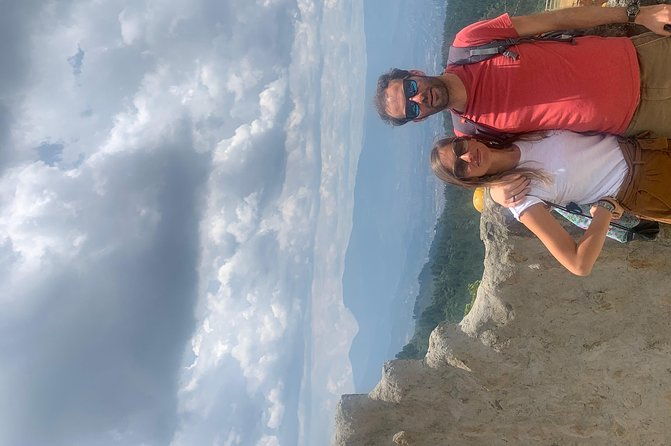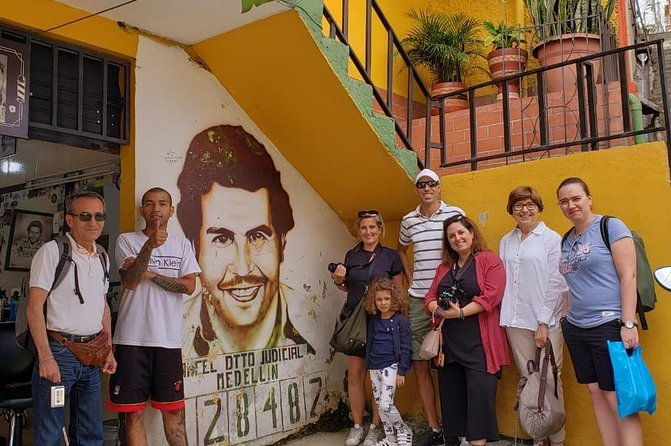The "History of Pablo Escobar Tour" provides visitors with a captivating glimpse into the tumultuous past of Medellín. Exploring key locations linked to the infamous drug lord’s reign, the tour offers a unique opportunity to understand the complexities of Escobar’s impact on the city. From his former residences to significant events, the tour sheds light on Medellín’s transformation from a hub of cartel violence to a vibrant urban center. Participants are left to ponder the lasting legacy of this controversial figure and the city’s resilience in the face of such a turbulent history.
Key Points
-
Guided tours explore Escobar’s former drug empire, including his luxurious Hacienda Nápoles estate and the sites of his notorious criminal activities.
-
Tours provide historical context on the rise and fall of the Medellín Cartel, highlighting Escobar’s brutal reign and the city’s transformation after his death.
-
Visitors can see the rooftop where Escobar was killed, the prison he built for himself, and the neighborhoods that suffered under his violent control.
-
The tours address the ongoing debates surrounding Escobar’s legacy, offering diverse perspectives on his impact and the broader effects of the drug trade.
-
Guides emphasize the city’s transition from the violence of the Escobar era to its current status as a model of urban renewal and resilience.
Medellín’s Dark Past

Medellín’s past is marked by the rise and reign of Pablo Escobar, one of the most notorious drug lords in history. As the leader of the Medellín Cartel, Escobar amassed immense wealth and power through the production and distribution of cocaine.
His reign was characterized by ruthless violence, political corruption, and the terrorization of the city’s residents. Escobar’s influence was far-reaching, and his legacy continues to shape Medellín’s reputation today.
The dark history of this period serves as a sobering reminder of the consequences of unchecked greed and the devastating impact of the drug trade.
Fascinated by the past? Here are other historical experiences we've covered in Medellin
The Rise of the Medellin Cartel

The rise of the Medellín Cartel was a critical chapter in Escobar’s criminal empire. Under his leadership, the cartel became the world’s largest cocaine trafficking organization.
Escobar exploited political corruption, intimidation, and violence to expand his operations. The cartel’s ruthless tactics, including bombings and assassinations, terrorized the city.
Escobar’s vast wealth and influence allowed him to evade authorities for years. However, his reign of terror ultimately led to his downfall as the Colombian government and U.S. law enforcement intensified their pursuit.
The Medellín Cartel’s collapse marked the end of Escobar’s criminal dominance, though his legacy continues to fascinate and horrify.
Pablo Escobar’s Criminal Empire
Although Escobar’s criminal empire was centered in Medellín, his influence and drug trafficking operations expanded far beyond the city limits.
By the 1980s, the Medellin Cartel had become the world’s largest supplier of cocaine, controlling over 80% of the global market.
Escobar’s vast wealth and ruthless tactics allowed him to bribe and terrorize politicians, law enforcement, and the general public.
He built a private army to defend his interests and eliminate rivals, leading to a brutal turf war that claimed thousands of lives.
Escobar’s reign of terror made him one of the most notorious criminals in modern history.
The War on Drugs and Pablo Escobar
Pablo Escobar’s criminal empire and the Medellín Cartel’s dominance of the global cocaine trade eventually drew the attention of international authorities and sparked a war on drugs.
The Colombian government, with support from the United States, launched a massive crackdown to dismantle Escobar’s operations. A violent confrontation ensued, leading to the deaths of thousands.
Escobar evaded capture for years but was eventually killed in 1993 during a rooftop shootout with authorities.
The war on drugs continues to have lasting impacts on Colombia, with ongoing efforts to combat the illicit drug trade and address its societal consequences.
Escobar’s Downfall and Death
After years of eluding authorities, Pablo Escobar’s criminal empire began unraveling as the Colombian government, with support from the United States, intensified its crackdown on the Medellín Cartel.
In 1993, Escobar escaped from his luxurious prison, sparking a nationwide manhunt. Relentless pursuit by the Search Bloc, a specialized police unit, and the rival Cali Cartel’s informants led to Escobar’s downfall.
On December 2, 1993, he was shot dead on a rooftop in Medellín while attempting to flee. Escobar’s death marked the end of an era and the dismantling of the infamous cartel he’d built.
- Pablo Escobar Museum
- Day Trip to Guatapé With ,Breakfast, Lunch and Boat Ride
- Half Day Bike Tour in Medellin – Local Food, Coffee and Beer
- Guatapé Rock Del Peñol Excursion + Gastronomic Tour and Cruise on the Dam
- Comuna 13 Graffitour Knows the Urban Art District of Medellín
- Half-Day Coffee Tour in Medellín: From the Seed to the Cup
The Impact on Medellín
The death of Pablo Escobar had a profound impact on the city of Medellín, transforming it from a hub of cartel violence to a destination for urban renewal and economic growth.
Medellín’s transformation from cartel violence to urban renewal and economic growth followed the death of notorious kingpin Pablo Escobar.
The once-notorious neighborhoods associated with the Medellin Cartel have undergone significant redevelopment, with new parks, libraries, and community centers replacing the drug dens and safe houses of the past.
Tourism has also emerged as a vital industry, with visitors drawn to learn about Escobar’s legacy and the city’s remarkable turnaround.
Today, Medellín is celebrated as a model of urban revitalization, a testament to the resilience of its people.
Controversial Legacy of Pablo Escobar
Despite the profound transformation of Medellín, Pablo Escobar’s controversial legacy continues to spark intense debates.
While some view him as a Robin Hood figure who championed the poor, others condemn his ruthless methods and the devastation he brought to the city.
His legacy raises complex questions:
-
Was Escobar a product of his environment or solely responsible for his actions?
-
Do the tours glorify or humanize a notorious criminal?
-
Should Medellín embrace or distance itself from this chapter of its history?
-
How can the city balance truth-telling with sensitivity towards victims and their families?
Exploring Escobar’s Haunts in Medellín
Amidst the complex debates surrounding Pablo Escobar’s legacy, a growing number of visitors to Medellín seek to explore the haunts and sites associated with the infamous drug lord.
These guided tours provide an alternative sightseeing experience, offering an in-depth understanding of the local history beyond typical tourist guidebooks. Participants are transported in comfort to significant locations, including Escobar’s grave, while gaining personalized insights from English and Spanish-speaking guides.
The private nature of the tours ensures an exclusive experience tailored to each group. Despite the controversial nature of Escobar’s activities, the tour has garnered positive reviews from travelers seeking a nuanced exploration of Medellín’s past.
Frequently Asked Questions
Does the Tour Include Visiting Locations Related to Other Drug Lords?
The tour focuses solely on locations related to Pablo Escobar and doesn’t include visiting sites associated with other drug lords. The experience is tailored to provide an in-depth understanding of Escobar’s life and impact on Medellín’s history.
Can I Take Photos During the Tour?
Yes, visitors can take photos during the tour. The overview indicates the tour provides a personalized experience, and there’s no mention of any restrictions on photography. Guests are encouraged to capture the significant locations related to Pablo Escobar’s history.
How Much Walking Is Involved in the Tour?
The tour involves moderate walking, with stops at significant locations like Escobar’s grave. Guests can expect to walk for roughly an hour or less during the half-day excursion. The tour is wheelchair accessible, and infant seats are available.
Are There Any Age Restrictions for the Tour?
The tour has no age restrictions, and it’s suitable for most travelers. Children, including infants, can participate, with infant seats available. The tour is wheelchair accessible and allows service animals.
What Safety Precautions Are Taken During the Tour?
The tour ensures passenger safety with comfortable transportation and an experienced guide. Safety features include wheelchair accessibility, infant seats, and allowance of service animals. Tours adhere to all local regulations for a secure and enjoyable excursion.
More 2-Day Experiences in Medellin
- Coffee Zone 2 Days All Inclusive Jardin and Jerico From Medellin
- Electric Mountain Bike Tour in Wild Colombia – 2 Days
- 2 Days Private Adventure Tour: Rafting and Camping in Antioquia
- Rio Samana 2 Days Rafting Expedition
- Rio Verde 2 Day Expedition – Rafting Medellín
- 2-Day: Pablo Escobar, Comuna 13, Guatape Including Boat Ride and La Manuela
More Boat Tours & Cruises in Medellin
- Pablo Escobar Paintball Mansion Boat Trip From Guatapé
- Private Exclusive Helicopter and Boat Tour
- Guatapé Tour and Dam Boat Tour From Medellín
- Guatape Private Tour. Farm, Boat Ride, La Piedra and More…
- Tour to Guatapé + Rumbero Boat + Access to the Stone
- Guatape Tour + Boat Ride + Coffee Tour “Best Experience”
More Tour Reviews in Medellin
Still browsing? Here are more Medellin experiences we've covered recently
- Venice Dreamscape: Romantic Spa Experience for Two
- City Tour + Commune 13 Medellin
- RIO CLARO (doradal)
- Guatapé tour
- Tour Guatapé
- Tour to the Hacienda Nápoles Theme Park
- Santa Fe de Antioquia Tour with Western Bridge Visit
- Tour to Río Claro and La Caverna del Cóndor
- Marmoleo Restaurant Helicopter Tour.
- Coffee Lovers Express Coffee Tour
- Transformation Tour
- Hacienda Nápoles Tour
